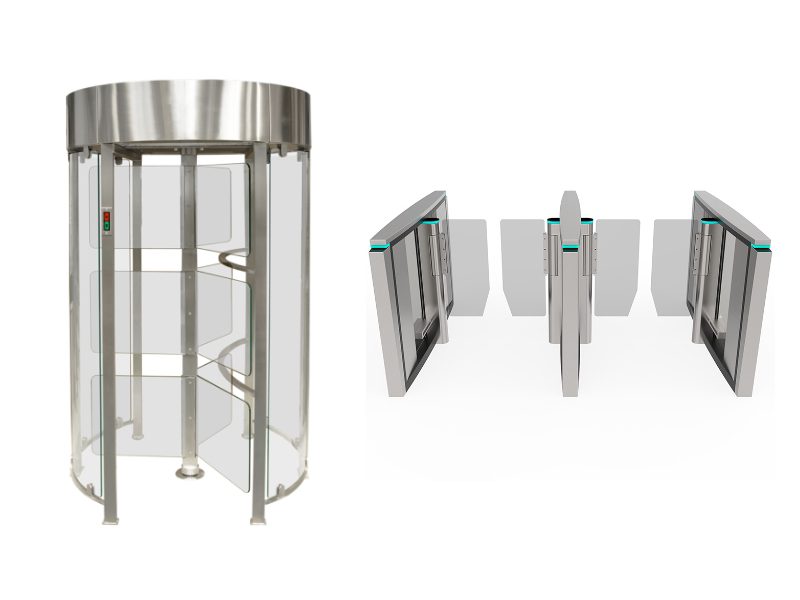Selecting the right turnstile for your entrance isn’t just about security, it’s also about flow, experience, and future-proofing your space. Whether you’re managing a secure warehouse, a stylish office, or a public venue, choosing between a full-height turnstile and a waist-height turnstile can impact everything from safety to user experience.
In this guide, we’ll be breaking down both options and helping you find the perfect access solution that balances aesthetics, control, and scalability.
Why your turnstile choice matters
Turnstiles play a critical role in entrance security for businesses. Beyond restricting unauthorised access, modern security turnstiles also integrate with digital systems such as QR readers, RFID cards and biometrics, which all support crowd control.
Making the right choice ensures you optimise security without compromising convenience, match turnstile type to your building’s traffic and purpose and future-proof your entry solution with technology that can scale and support you.
The two most common types of turnstiles – full-height and waist-height turnstiles, serve different needs and different businesses may see benefits from different options. Let’s explore each.
Full-height turnstiles: high-level physical security
A full-height turnstile could be described as a human-sized gate, offering floor-to-ceiling access control. These are built for resilience and authority, making them ideal for environments where security breaches are a challenge, and you want advanced security.
Key features:
- Rotating steel or aluminium arms form a complete physical barrier, or choose glass-pass turnstiles for a professional finish
- Can operate bi-directionally or uni-directionally
- Optional features: anti-tailgating, time-delay rotation, integration with CCTV or biometric readers
Best for:
- Industrial facilities and construction sites needing strong perimeter control
- Government or military premises requiring high-security protocols
- Transport hubs like train stations to prevent fare evasion and unauthorised access
Benefits:
- Acts as a security turnstile that deters physical breaches
- Operates reliably in outdoor or unsupervised conditions
- Works seamlessly with high-security access systems
If you need an entry solution that prevents piggybacking or bypassing, this is your go-to.
Waist-height turnstiles: efficient and welcoming
For settings that balance safety with aesthetics, a waist-height turnstile, or tripod turnstiles, are often the right choice. These units provide moderate security while maintaining a sleek, professional look.
Key features:
- Rotating tripod or barrier arms at waist level
- Available in stainless steel or glass for visual appeal
- Compatible with scanners, card readers, and people counters
Best for:
- Corporate offices, especially reception areas
- Universities, libraries, and museums
- Fitness and leisure centres and public venues such as stadiums, where user flow matters
Benefits:
- Less intrusive than full-height barriers
- Enables smooth traffic flow during peak hours
- Easier to install in tight or open-plan spaces
If your priority is combining control with an inviting environment, this access solution is a great choice.
Choosing between full-height and waist-height turnstiles
When deciding between these two turnstile types, you need to consider some key factors. First, start by looking at your space and then, ask yourself the following:
1. What level of security do you need?
- Full-height turnstiles are best for high-security areas.
- Waist-height turnstiles suit spaces requiring less monitoring or CCTV.
2. What is your traffic volume?
- Waist-height models process users faster.
- Full height designs slow entry intentionally for better control.
3. How important is design and user experience?
- Public-facing environments benefit from the elegance of waist-height turnstiles.
- Industrial or secured environments prioritise function over form.
4. Do you need scalability or integration?
- Both turnstiles support integration, but full-height options often offer greater physical control.
- Waist-height units have the benefit of easier upgrades and visual branding options.
Other turnstile options to consider
While this blog focuses on the two most popular types of turnstiles, here at EA, we offer a range of entry solutions to fit different environments and requirements. You may want to consider all your options, such as:
- Speed gates or optical turnstiles for ultra-fast access in high-end corporate lobbies
- Portable turnstiles for temporary events or mobile security setups
- Security turnstiles with anti-passback, alarm triggers, and real-time analytics
- Electromechanical turnstiles offering 30 passes in 1 minute.
These hybrid options may offer the flexibility your site demands. You might be after something like a speed lane, which offers a touchless and modern experience. This is ideal for sites such as airports or busy, high-traffic environments.
Investment in security and experience with the right turnstile
Whether you choose a full-height turnstile for the ultimate security setup or a waist-height turnstile for a smoother flow, what’s important is to match the unit to your unique business environment and needs.
Your entrance security and access control should combine goals like safety, design, throughput, and a way to future-proof your premises, streamline traffic and deter threats.
If you’re ready to upgrade your access solution, or want to discuss your options, chat to our team about a tailored recommendation that suits your building, brand, and budget.





















